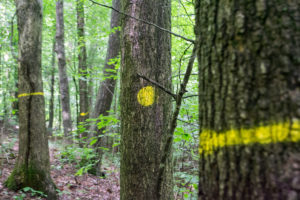On June 11, IFA intern Anna Hopkins took her camera to Owen-Putnam State Forest to survey two soon-to-be-logged forest tracts with members of Owen-Putnam Friends of the Forest (photos here). Nearly 2,000 trees, or 485,000 board feet of timber, will be sold at auction on Wednesday morning at 9 a.m., June 20, 2018. This is more than were sold at Yellowwood cut, and from a smaller acreage area. The Friends are peaceably assembling June 20 to take a stand for more conservative, more balanced approach to logging in this and all state forests. Contact them to learn more and take part.
by Anna Hopkins
Standing in the middle of the Owen-Putnam State Forest, you feel you have walked into a fairy tale. The sun streams through the towering forest canopy, washing the saplings and plants below in golden haze. The earthy breeze carries the sound of rushing waters and bird call. This gem of an Indiana state forest could almost be mistaken for paradise. Almost.
 Upon closer inspection you can see that many of the most majestic trees have been marked with yellow spray paint, either single dots or thin rings all the way around the trunks. These doomed trees are next to seeps, along the road, on the inclines above Fish Creek, or directly next to historic heritage sites, the remnants of historic cabins. We even saw a marked tree right behind a wooden sign that read NO MOTOR VEHICLES BEYOND THIS POINT. Logging trucks will be the exception.
Upon closer inspection you can see that many of the most majestic trees have been marked with yellow spray paint, either single dots or thin rings all the way around the trunks. These doomed trees are next to seeps, along the road, on the inclines above Fish Creek, or directly next to historic heritage sites, the remnants of historic cabins. We even saw a marked tree right behind a wooden sign that read NO MOTOR VEHICLES BEYOND THIS POINT. Logging trucks will be the exception.
It’s alarming to me to consider the amount of damage that could result from this logging plan. We saw two ash trees marked for cutting that appeared to show no signs of emerald ash borer infestation. How are we supposed to stop the ash borer if we are cutting trees that seem to be evading the insect or could even be resistant to it?
Many of the other trees that were marked had only the problem of competing with the more monetarily valuable trees around them. From what I observed, the DNR believes it is better to create an optimal environment for a single oak by cutting down the surrounding trees rather than letting natural disturbances occur, thereby nurturing a diverse crop of hardwoods. Just one look across Fish Creek where logging in past years has taken place proves this point–we could count on one hand the number of trees besides oaks that were left growing.
If the sheer amount of trees being cut isn’t enough to alarm you (an estimated 285,922 board feet of timber in Compartment 5 Tract 6 and 199,204 board feet of timber in Compartment 8 Tract 7 according to DNR’s advertisement in the local paper), then consider the ripple effects of the logging. We hiked the path that the skidders will use to haul out the trees and noticed it was full of saplings, native plants (the Cardinal flower, the Paw Paw tree, and the Christmas fern) and also extremely close to creeks and seeps. All these plants and saplings will be wiped out and the creeks will be burdened with increased silt and erosion.
Once the skidders exit the deeper parts of the tract, they will emerge onto a gravel road where the timber will be loaded onto trucks. Emerging onto these gravel paths from the depths of the forest was breathtaking. Flanked on both sides by towering trees illuminated in the hazy afternoon light, it felt like I was walking into a computer screensaver. I imagine the place will be unrecognizable after trucks loaded with 80,000 pounds of timber create deep ruts on the path, disturbing the surrounding trees with their oversized load.
Just one visit to Owen-Putnam State Forest was enough to make me incredibly angry at the claim that cutting these trees will create a healthier forest. Will it lead to a quick profit? Yes, despite the timber selling for less than it does on private land. Will it lead to a more profitable forest in the future? Maybe.
Will it lead to a better environment for Indiana forest-goers and the flora and fauna that already inhabit this deep forest? Absolutely not.

